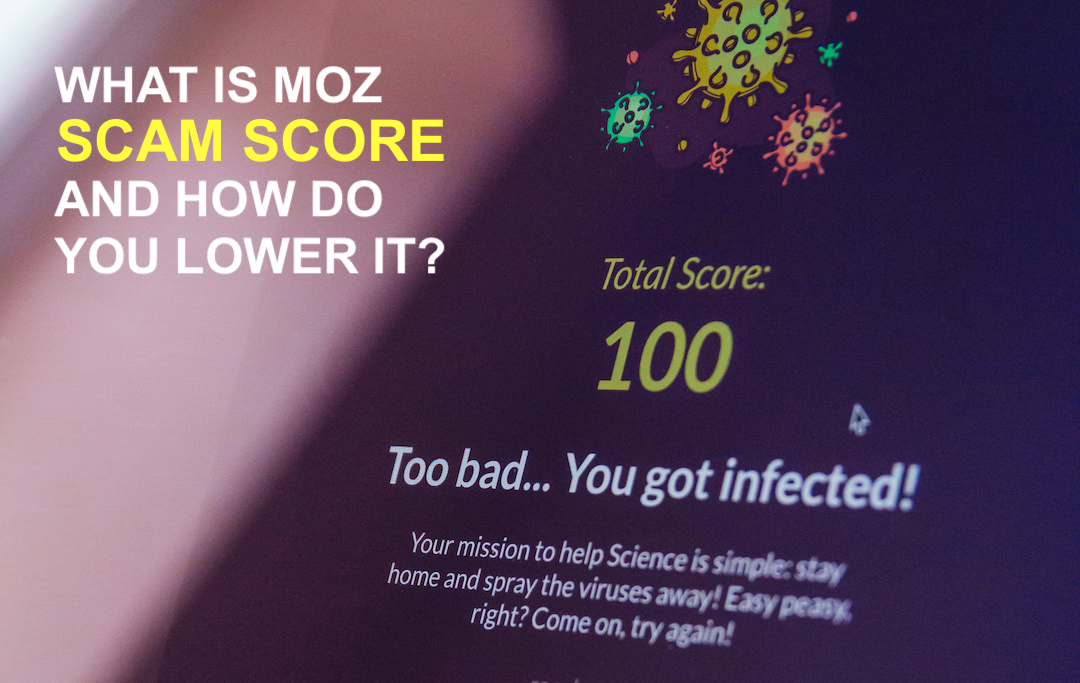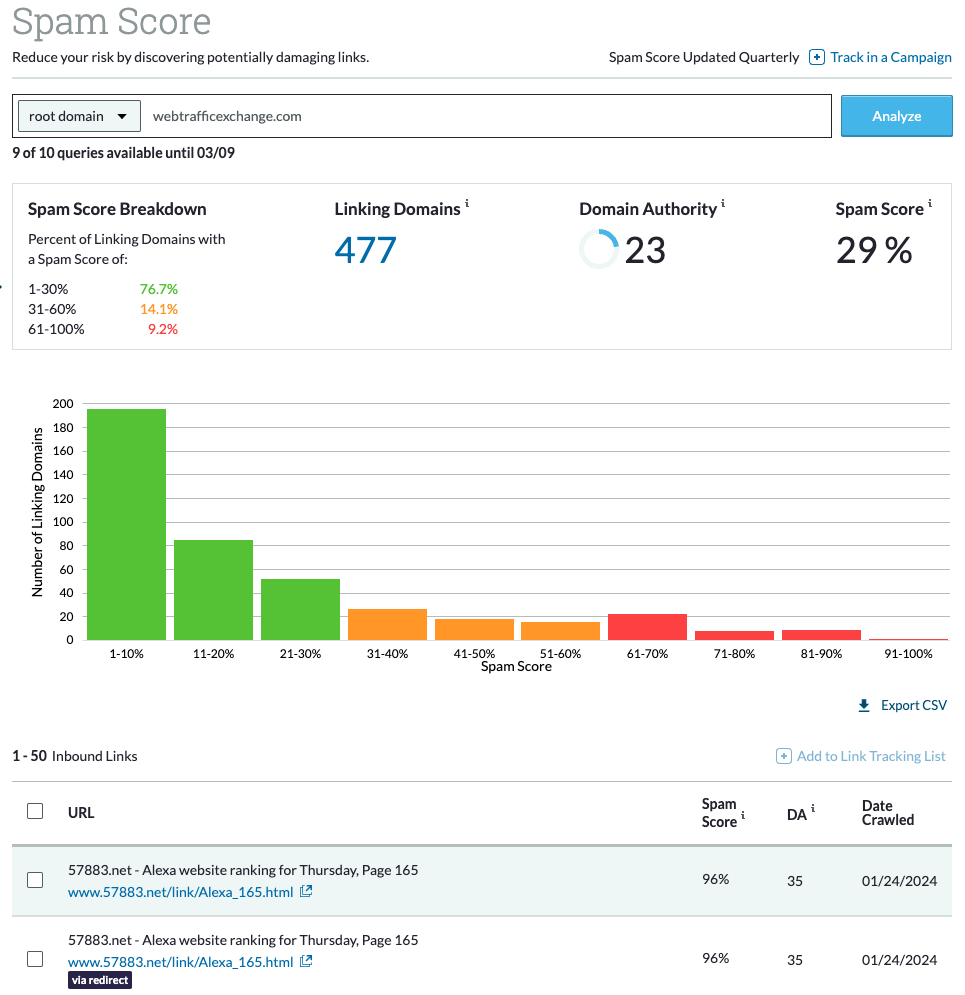
We have a collection of websites built using various CMS systems, and Webtraffic Exchange in particular was originally built with Drupal. The site has been around since January 2007, and we've added nearly 200 articles over time. During the course of its lifespan, we've lost our focus due to lack of time and kept the website unmanaged. After nearly 17 years, we realized that the site has a Moz spam score of 29 which is not a very healthy number. The primary reason for having such a high spam score was due to leaving the blog comment system open to the public, and not cleaning up spammy links.
Reducing the spam score of our website to a single-digit number is crucial for maintaining a good reputation and ranking higher on search engines. So, here we go analyzing what we can do to improve our Moz spam score.
What is Moz Spam Score?
Moz's Spam Score is a metric developed by Moz to estimate the likelihood that a website is penalized or banned by search engines due to spammy or low-quality backlinks. Moz analyzes various factors such as the number of low-quality backlinks, the quality of referring domains, and other link-related metrics to determine the Spam Score between 1 - 100%. Moz makes Domain Authority Checker and Link Explorer tools to allow the user to check their spam scores as well as Domain Authority and Page Authority scores.
What are the characteristics of Moz Spam Score?
Spam score assesses the penalty risk based on similar sites, and it is not a direct "spamminess" measure. A higher score doesn't automatically mean spam, so investigate the underlying factors before disavowing links. The score is based on a machine learning model that identifies 27 common features among millions of banned or penalized sites.
Spam Scores are categorized as:- Low (1-30%): Likely safe.
- Medium (31-60%): Needs investigation.
- High (61-100%): Exercise caution and consider further analysis.
What are the main causes of having a high Moz spam score?
Several factors can contribute to a high Moz Spam Score for a website. Here are some of the main causes:
- Low-quality backlinks: Backlinks from spammy or low-quality websites can significantly impact your Spam Score. These may include links from link farms, paid link schemes, or irrelevant websites.
- Irrelevant anchor text: Overuse of exact-match or irrelevant anchor text in backlinks can signal manipulation to search engines and contribute to a high Spam Score.
- Link network patterns: Patterns indicating artificial link networks, such as reciprocal linking schemes or excessive link exchanges, can raise red flags and increase your Spam Score.
- Thin or low-quality content: Websites with thin, duplicated, or low-quality content may be perceived as less trustworthy by search engines, leading to a higher Spam Score.
- Unnatural link velocity: Rapid and unnatural growth in the number of backlinks to your website can indicate manipulative link-building practices and result in a higher Spam Score.
- Historical penalties: Past penalties or algorithmic actions taken against your website by search engines can contribute to a high Spam Score.
- Malware activities: Websites associated with malware, phishing, or other malicious activities can be flagged by Moz and receive a higher Spam Score.
- Domain age and authority: New domains or domains with little authority may initially have higher Spam Scores due to limited historical data.
Addressing these factors through proactive link auditing, content optimization, and adherence to best SEO practices can help lower your website's Moz Spam Score and improve its overall search engine performance.
How do you improve Moz's spam score?
To lower your website's Moz Spam Score, you should focus on improving the quality of your backlink profile. Focus on building high-quality, relevant backlinks from trustworthy websites while removing low-quality links. Here are some steps:
1. Investigate the Score
Investigate your scam score by using Moz Link Explorer -> Link Research -> Spam Score. Analyze the flagged sites for spammy characteristics, and prioritize investigating links with high Spam Scores and clear spam indicators.

2. Removing spammy or low-quality backlinks
Identify and disavow any backlinks that are from irrelevant, low-quality, or suspicious websites. Use this option cautiously, as disavowing valuable links can harm your SEO. You can use tools like Moz's Link Explorer or Google Search Console to identify these links.
3. Build High-Quality Backlinks
Focus on organic link-building strategies like guest blogging, creating valuable content, and outreach to relevant websites. Aim to have a diverse range of backlinks coming from different types of websites and trustworthy sources.
Avoid buying or exchanging links, or other black-hat SEO tactics, as they can further increase your Spam Score and potentially harm your ranking.
4. Optimize anchor text
Ensure that the anchor text used in your backlinks is natural, varied, and relevant to the linked content. Avoid over-optimizing with exact-match anchor text, which can signal manipulation to search engines.
5. Remove or update low-quality content
Review your website's content and identify any pages that are thin, duplicated, or low-quality. Either improve the content to make it more valuable and relevant, or consider removing it altogether.
6. Secure your website
Ensure that your website is secure and free from malware or other security vulnerabilities. Regularly scan your website for potential threats and address any issues promptly.
7. Monitor Progress
Track your Spam Score over time to see if your efforts are paying off. Remember, SEO is a long-term game, and lowering your Spam Score may take time and consistent effort. Remember, a single metric shouldn't dictate your entire SEO strategy. Use Spam Score as a warning sign to investigate potential issues and focus on building a strong, natural backlink profile for long-term success.
How long does it take to lower your spam score?
The time it takes to lower your website's Moz Spam Score can vary depending on several factors, including the severity of the issues contributing to the high score, the effectiveness of your efforts to address those issues, and the frequency with which Moz updates its Spam Score algorithm.
In general, you may start to see improvements in your Spam Score within a few weeks to a few months if you are actively working to address the factors contributing to the high score. However, it's important to note that SEO is a long-term strategy, and significant improvements in Spam Score may take several months or even longer to achieve, particularly if your website has a high number of spammy backlinks or other serious issues.
Here are some factors that can influence the timeline for lowering your Spam Score:
- Severity of issues: If your website has a high number of spammy backlinks or other serious issues contributing to a high Spam Score, it may take longer to address these issues and see improvements in your score.
- Effectiveness of efforts: The effectiveness of your efforts to address the factors contributing to your high Spam Score will also impact how quickly you see improvements. If you are proactive and successful in removing or disavowing spammy backlinks and improving the overall quality of your backlink profile, you may see faster improvements in your Spam Score.
- Moz algorithm updates: Moz periodically updates its Spam Score algorithm, which can impact how your website's score is calculated. Changes to the algorithm can influence the timeline for lowering your Spam Score.
- Disavowing process: Disavowing links itself takes 48 hours for Google to process.
- However, it can then take weeks or even months for Google to re- crawl your website and factor in the disavowed links, reflecting the change in your score.
- Building high-quality backlinks: Creating valuable content and attracting natural backlinks naturally takes time, impacting your score gradually.
- Google's re-crawling frequency: Google regularly crawls websites, but the exact frequency varies, affecting how quickly your score updates.
While it's possible to see improvements in your Spam Score relatively quickly with proactive efforts, significant improvements may take several weeks to several months. The key is to consistently implement the right strategies and be patient while Google re-evaluates your website.
Conclusion
Lowering your Spam Score takes time and consistent effort, so don't expect overnight results. Focus on building a sustainable and healthy website with natural link profiles and high-quality content for long-term SEO success. Spam Score is just one indication of your overall SEO health, so use it as a guide to identify potential issues and prioritize improvements.
References
For further resources, check out Moz's official information on Spam Score:
Share this post
Leave a comment
All comments are moderated. Spammy and bot submitted comments are deleted. Please submit the comments that are helpful to others, and we'll approve your comments. A comment that includes outbound link will only be approved if the content is relevant to the topic, and has some value to our readers.

Comments (0)
No comment